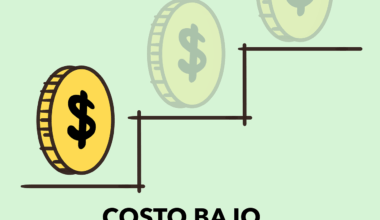Understanding the Loan-to-Value Ratio
When discussing loans, the Loan-to-Value (LTV) ratio is crucial for borrowers and lenders alike. The LTV ratio represents the percentage of a property’s value that is financed through a loan. A high LTV ratio indicates that the borrower is leveraging more debt compared to own equity during purchase. For instance, an LTV of 80% means that 80% of the home’s value is financed through the loan. LTV is significant in determining risk; lenders prefer lower LTV ratios as they imply borrower stability and lower risk of default. It affects interest rates, mortgage insurance requirements, and loan eligibility. Various factors influence the LTV ratio, most notably the down payment made by the borrower. A larger down payment results in a lower LTV ratio, thus decreasing the associated risks for the lender. Borrowers should strive for a lower LTV ratio to enhance their borrowing power. Understanding the LTV ratio can empower borrowers to make informed financial decisions regarding home purchases and refinancing options. Consequently, it’s pivotal to comprehensively analyze this ratio to secure favorable loan terms.
How the LTV Ratio Works
The LTV ratio is calculated by dividing the loan amount by the appraised value of the property or its purchase price, whichever is lesser. Understanding how the LTV ratio functions is essential for navigating mortgage options and securing favorable terms. To calculate, take the loan amount and the property value, then apply the formula: LTV = (Loan Amount / Property Value) x 100. Accurate calculations are crucial, as this ratio impacts mortgage insurance premiums and the overall monthly payment. Lowering the LTV ratio can improve loan conditions significantly, making homeownership more attainable. Lenders utilize this metric to assess risk and determine loan terms, including interest rates and insurance rates. If a borrower has a high LTV ratio, they may face higher interest rates or the requirement for private mortgage insurance (PMI). Lower LTV ratios can reduce overall borrowing costs and provide better loan terms. Hence, it’s advisable to work towards a lower LTV ratio by making significant down payments or improving property value through renovations to enhance their financial standings.
The Importance of a Low LTV Ratio
An optimal LTV ratio is essential to ensure reasonable borrowing costs and better loan options. Lenders generally view lower LTV ratios as favorable because they signify a lower risk of default. This, in turn, allows borrowers to qualify for better interest rates and may eliminate the necessity for mortgage insurance. A low LTV ratio often results from substantial down payments, which effectively demonstrate to lenders a borrower’s commitment to the investment. The commitment displayed by a larger down payment indicates financial stability and capability to manage debt. Those who can significantly contribute upfront generally enjoy lower monthly payments and overall borrowing costs. Borrowers aspiring for homeownership should prioritize reducing their LTV ratio by strategizing down payment amounts carefully. Additionally, consistent property appreciation can aid in reducing the LTV ratio over time, further enhancing borrowing potential. As the property value increases, the division in the LTV equation shifts favorably, reducing potential financial burdens. Thus, understanding the significance of the LTV ratio directly impacts the future financial decisions of potential homeowners.
Borrowers can improve their LTV ratio through smart financial strategies. For instance, aiming to save for a larger down payment is a proactive approach. Additionally, enhancing your credit score can prove beneficial during the loan application process. Lenders typically favor applicants with better credit scores, equating them to lower perceived risks. Furthermore, maintaining a stable income and low debt-to-income ratio also contributes positively. Paying off high-interest debts can free up cash flow, allowing for higher down payments when purchasing a property. Continuous evaluation of personal financial health ensures a favorable position when applying for a loan. Additionally, consider working with financial advisors to explore viable pathways to lower the LTV ratio. An informed approach to managing finances can greatly enhance loan eligibility, allowing for greater buying power in prospective home purchases. Seek guidance in understanding the nuances surrounding mortgages, which can further provide clarity on interest rates, terms, and conditions. Ultimately, striving towards a lower LTV ratio serves not just to secure benefits now but lays the groundwork for robust financial decisions in the foreseeable future.
Risks Associated with High LTV Ratios
High LTV ratios pose several risks for both borrowers and lenders. Borrowers with a significant portion of their property financed through loans face heightened exposure to market fluctuations. A decline in property values can easily place borrowers in a negative equity situation, where they owe more than the property’s worth. This financial ambiguity can lead to challenges in refinancing and could complicate selling the property, resulting in potential losses. Moreover, lenders perceive high LTV ratios as a significant risk. Consequently, they often impose stricter lending conditions, elevated interest rates, and, at times, the necessity for private mortgage insurance (PMI). PMI adds an extra monthly expense, increasing the overall cost of homeownership. Furthermore, borrowers facing potential default may discover limited recourse or options for financial recovery. High debt levels coupled with sudden economic downturns can precipitate foreclosure risks. Therefore, understanding the implications of high LTV ratios is fundamental for responsible financial planning. Borrowers should aim for a sustainable debt level to avoid exposure to risks posed by volatility in the housing market and ensure long-term financial health.
Navigating LTV Ratios for First-time Homebuyers
First-time homebuyers often face unique challenges regarding LTV ratios as understanding these ratios can be daunting. It’s imperative for newcomers to the housing market to become educated about how LTV ratios affect their mortgage options. They should seek to maintain an awareness of prevailing market conditions and set aside considerable savings for down payments. By doing so, they can ensure they navigate home buying without falling into the trap of high LTV ratios. Researching lenders and understanding their requirements can provide necessary insights before committing to a loan. Additionally, assistance from first-time homebuyer programs often offers lower down payments, although it may inadvertently lead to higher LTV ratios. Ensuring thorough knowledge of these programs and their implications can inform better decisions. Consulting financial advisors is also advised, as they can help tailor unique strategies that suit individual financial situations and mitigate risks associated with high LTV scenarios. The journey of homeownership begins with comprehensive education and preparation, allowing first-time buyers to navigate potential pitfalls effectively.
In summary, the Loan-to-Value ratio plays a pivotal role in the realm of financial literacy, especially regarding loans. Understanding its implications enables borrowers to make informed decisions on home purchases, refinancing, and overall financial health. Lowering the LTV ratio can enhance financial options and provide leverage in negotiations, ensuring favorable borrowing conditions. As such, it is paramount for borrowers to prepare adequately before applying for any mortgage loan. Through savings for substantial down payments and maintaining strong credit, they can unlock better loan terms and minimize associated costs. Awareness of the risks accompanying high LTV ratios further emphasizes the need to mitigate debt exposure. Educating oneself about LTV ratios and maintaining financial health should remain a priority. For comprehensive financial stewardship, support and guidance from professionals can provide clarity on the complexities of mortgages and loans. Therefore, aspiring homeowners should view LTV ratios not merely as numbers, but as vital indicators which will strongly influence their financial futures. By fostering strong financial foundations through understanding, borrowers can make substantial strides in their homeownership journeys.


